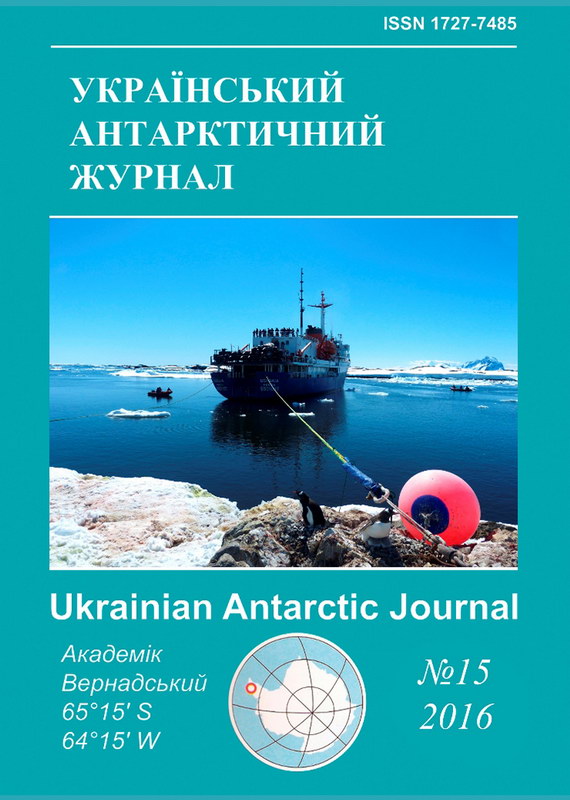- tundra,
- cold environments,
- primitive soils,
- permafrost,
- ornithogenic

This work is licensed under a Creative Commons Attribution-NonCommercial-NoDerivatives 4.0 International License.
Abstract
Tundra soils were formed in a cold environment with harsh winters and short growing season. Most of them are primitive in terms of their profile differentiation and depth. Therefore, studying these soils is important for understanding the initial stages of pedogenesis. Many studies in this field have been carried out in arctic and alpine environments, but there is still some lack of information about Antarctic soils. However, primitive soils of Antarctic tundra and other cold environments may be incomparable because of their different genesis. Impact of ornithogenic products on tundra soils and habitats in Southern Hemisphere is much stronger than in Arctic or alpine environments; but many soils in the coastal Antarctica have no visible signs of ornithogenic influence. In this study we hypothesized that the high content of trace elements in soils may prove their ornithogenic origin. It may be caused by an intensive biogenic flux of chemical elements from marine to terrestrial ecosystems: plankton + microbenthos→N. сопсіппа→L. dominicanus→ guano + pellets (N. сопсіппа shells). In this study we investigated the content of trace elements in soils of Galindez Island and Skua Island (Wilhelm Archipelago). It was found that the content of Ca, Sr and Cd in soils formed on N. сопсіппа shells (ornithogenic soils) was significantly higher than in parent rock. Contents of Sr and Cd in soil have strongly correlated with content of Ca, which is the main component of mollusk shells. In some soils formed on rhyolites, the content of these elements in soil was much lower than in parent rock; but linear correlation between Ca and Sr (R2=0.997, p<0.001) as well as between Ca and Cd (R2=0.963, p<0.001) contents was as strong as in soils formed on N. сопсіппа shells. These results support the idea of ornithogenic origin of Ca, Sr and Cd in the Antarctic soils. A further study with a focus on the isotopic composition of these elements is therefore suggested.
References
- Abakumov, E. V. (2010). Istochniki i sostav gumusa nekotorykh pochv Zapadnoi Antarktiki [Sources and composition of the humus of some soils in West Antarctica]. Pochvovedenie, 2, 538-547. (in Russian)
- Abakumov, E. V. (2014). Zoogennyj pedogenez kak osnovnoj biogennyj pochvennyj protsess v Antarktide [Zoogenic paedogenesis as the main biogenic soil process in Antarctica]. Russkij ornitogennyj zhurnal, 23(972), 576-584. (in Russian)
- Zhovinskii, E. Ya., Nedogibchenko, S. M., Kriuchenko, N. O. (2014). Mikroelementy v kore vyvetrivania korennykh porod oazisa ostrova Galindez (Zapadnaia Antarktika) [Microelements in the erosion crust of bedrock of the oase on the Galindez Island (West Antarctic)]. Kriosfera Zemli, XVIII(3), 77-81. (in Russian)
- Zaimenko, N. V., Bedernichek, T. Yu., Khoyetskyy, P. B. (2016). Allelopathic activity of Antarctic hair grassin context of global climate changes. Bulleten of the Botanical Garden-Institute of the Far-Eastern Branch of the Russian Academy of Science, 15, 26-28. (in Russian)
- Karelin, D. V., Zamolodchikov, D. G. (2008). Uglerodnyi obmen v kriogennykh ekosystemakh [Carbon metabolism in kriogenic ecosystems]. M.: Nauka. (in Russian)
- Morozov, A. I. (2007). O pochve i pochvovedenii (vzgliad so storony) [On soil and soil science: outside looking in]. M.: GEOS. (in Russian)
- Nedogibchenko, S. M., Kryuchenko, N. O., Zovinskiy, E. Y. (2013). The features of distribution of microelements in surface deposits of Galindez Island (Western Antarctica). Ukrainian Antarctic Journal, 12, 39-44. (in Russian)
- Parnikoza, I. Yu., Abakumov, E. V., Dykyi, I. V. et al. (2014). Ornitogennye lokalitety Deschampsia antarctica v raione Argentinskih ostrovov (Pribrezhnaia Antarktika) [Ornithogenic localitets of Deschampsia antarctica in the region of the Argentine Islands (Maritime Antarctic)]. Russkij ornitologicheskii zhurnal, 23(1056), 3095-3107. (in Russian)
- Parnikoza, I. Yu., Abakumov, E. V., Dykyy, I. V. et al. (2015). Influence of birds on the spatial distribution of Deschampsia antarctica Desv. on Galindez Island (Argintinean Islands, Coastal Antarctic). Vestnik of Saint Petersburg University. Series 3: Biology, 1, 78-97. (in Russian)
- Favero, M., Silva, P., Ferreyra, G. (1997). Trophic relationships between the kelp gull and the Antarctic limpet at King George Island (South Shetland Islands, Antarctica) during the breeding season. Polar Biology, 17, 431-436.
- Peck, L. S., Baker, A. C., Conway, L. Z. (1996). Strontium labeling of the shell of the Antarctic limpet Nacella concinna (Strebel 1908). Journal of Molluscan Studies, 62, 315-325.
- Pereira, T. T., Schaefer, C. E. G., Ker, J. C. et al. (2013). Micromorphological and microchemical indicators of pedogenesis in ornithogenic cryosols (Gelisols) of Hope Bay, Antarctic Peninsula. Geoderma, 193, 311-322.
- Suda, C. N., Vani, G. S., de Oliveira, M. F. et al. (2015). The biology and ecology of the Antarctic limpet Nacella concina. Polar Biology, 38(12), 1949-1969.

